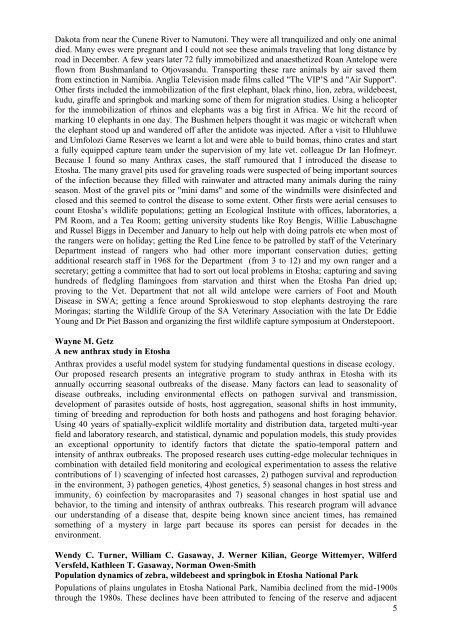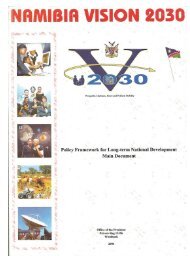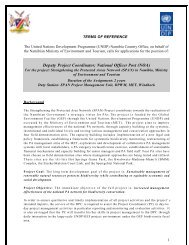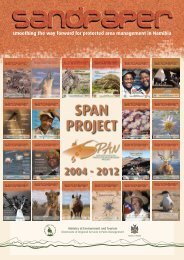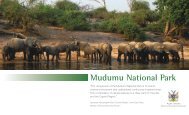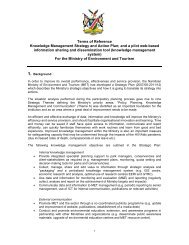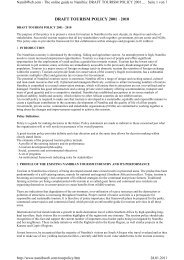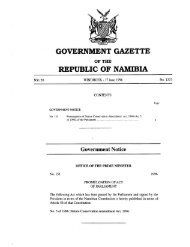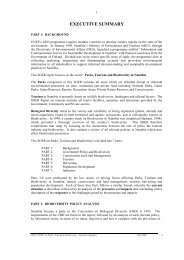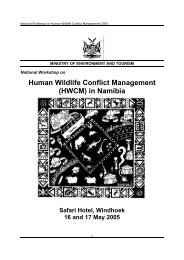Etosha: the Human Footprint - Ministry of Environment and Tourism
Etosha: the Human Footprint - Ministry of Environment and Tourism
Etosha: the Human Footprint - Ministry of Environment and Tourism
You also want an ePaper? Increase the reach of your titles
YUMPU automatically turns print PDFs into web optimized ePapers that Google loves.
Dakota from near <strong>the</strong> Cunene River to Namutoni. They were all tranquilized <strong>and</strong> only one animal<br />
died. Many ewes were pregnant <strong>and</strong> I could not see <strong>the</strong>se animals traveling that long distance by<br />
road in December. A few years later 72 fully immobilized <strong>and</strong> anaes<strong>the</strong>tized Roan Antelope were<br />
flown from Bushmanl<strong>and</strong> to Otjovas<strong>and</strong>u. Transporting <strong>the</strong>se rare animals by air saved <strong>the</strong>m<br />
from extinction in Namibia. Anglia Television made films called "The VIP‟S <strong>and</strong> "Air Support".<br />
O<strong>the</strong>r firsts included <strong>the</strong> immobilization <strong>of</strong> <strong>the</strong> first elephant, black rhino, lion, zebra, wildebeest,<br />
kudu, giraffe <strong>and</strong> springbok <strong>and</strong> marking some <strong>of</strong> <strong>the</strong>m for migration studies. Using a helicopter<br />
for <strong>the</strong> immobilization <strong>of</strong> rhinos <strong>and</strong> elephants was a big first in Africa. We hit <strong>the</strong> record <strong>of</strong><br />
marking 10 elephants in one day. The Bushmen helpers thought it was magic or witchcraft when<br />
<strong>the</strong> elephant stood up <strong>and</strong> w<strong>and</strong>ered <strong>of</strong>f after <strong>the</strong> antidote was injected. After a visit to Hluhluwe<br />
<strong>and</strong> Umfolozi Game Reserves we learnt a lot <strong>and</strong> were able to build bomas, rhino crates <strong>and</strong> start<br />
a fully equipped capture team under <strong>the</strong> supervision <strong>of</strong> my late vet. colleague Dr Ian H<strong>of</strong>meyr.<br />
Because I found so many Anthrax cases, <strong>the</strong> staff rumoured that I introduced <strong>the</strong> disease to<br />
<strong>Etosha</strong>. The many gravel pits used for graveling roads were suspected <strong>of</strong> being important sources<br />
<strong>of</strong> <strong>the</strong> infection because <strong>the</strong>y filled with rainwater <strong>and</strong> attracted many animals during <strong>the</strong> rainy<br />
season. Most <strong>of</strong> <strong>the</strong> gravel pits or "mini dams" <strong>and</strong> some <strong>of</strong> <strong>the</strong> windmills were disinfected <strong>and</strong><br />
closed <strong>and</strong> this seemed to control <strong>the</strong> disease to some extent. O<strong>the</strong>r firsts were aerial censuses to<br />
count <strong>Etosha</strong>‟s wildlife populations; getting an Ecological Institute with <strong>of</strong>fices, laboratories, a<br />
PM Room, <strong>and</strong> a Tea Room; getting university students like Roy Bengis, Willie Labuschagne<br />
<strong>and</strong> Russel Biggs in December <strong>and</strong> January to help out help with doing patrols etc when most <strong>of</strong><br />
<strong>the</strong> rangers were on holiday; getting <strong>the</strong> Red Line fence to be patrolled by staff <strong>of</strong> <strong>the</strong> Veterinary<br />
Department instead <strong>of</strong> rangers who had o<strong>the</strong>r more important conservation duties; getting<br />
additional research staff in 1968 for <strong>the</strong> Department (from 3 to 12) <strong>and</strong> my own ranger <strong>and</strong> a<br />
secretary; getting a committee that had to sort out local problems in <strong>Etosha</strong>; capturing <strong>and</strong> saving<br />
hundreds <strong>of</strong> fledgling flamingoes from starvation <strong>and</strong> thirst when <strong>the</strong> <strong>Etosha</strong> Pan dried up;<br />
proving to <strong>the</strong> Vet. Department that not all wild antelope were carriers <strong>of</strong> Foot <strong>and</strong> Mouth<br />
Disease in SWA; getting a fence around Sprokieswoud to stop elephants destroying <strong>the</strong> rare<br />
Moringas; starting <strong>the</strong> Wildlife Group <strong>of</strong> <strong>the</strong> SA Veterinary Association with <strong>the</strong> late Dr Eddie<br />
Young <strong>and</strong> Dr Piet Basson <strong>and</strong> organizing <strong>the</strong> first wildlife capture symposium at Onderstepoort.<br />
Wayne M. Getz<br />
A new anthrax study in <strong>Etosha</strong><br />
Anthrax provides a useful model system for studying fundamental questions in disease ecology.<br />
Our proposed research presents an integrative program to study anthrax in <strong>Etosha</strong> with its<br />
annually occurring seasonal outbreaks <strong>of</strong> <strong>the</strong> disease. Many factors can lead to seasonality <strong>of</strong><br />
disease outbreaks, including environmental effects on pathogen survival <strong>and</strong> transmission,<br />
development <strong>of</strong> parasites outside <strong>of</strong> hosts, host aggregation, seasonal shifts in host immunity,<br />
timing <strong>of</strong> breeding <strong>and</strong> reproduction for both hosts <strong>and</strong> pathogens <strong>and</strong> host foraging behavior.<br />
Using 40 years <strong>of</strong> spatially-explicit wildlife mortality <strong>and</strong> distribution data, targeted multi-year<br />
field <strong>and</strong> laboratory research, <strong>and</strong> statistical, dynamic <strong>and</strong> population models, this study provides<br />
an exceptional opportunity to identify factors that dictate <strong>the</strong> spatio-temporal pattern <strong>and</strong><br />
intensity <strong>of</strong> anthrax outbreaks. The proposed research uses cutting-edge molecular techniques in<br />
combination with detailed field monitoring <strong>and</strong> ecological experimentation to assess <strong>the</strong> relative<br />
contributions <strong>of</strong> 1) scavenging <strong>of</strong> infected host carcasses, 2) pathogen survival <strong>and</strong> reproduction<br />
in <strong>the</strong> environment, 3) pathogen genetics, 4)host genetics, 5) seasonal changes in host stress <strong>and</strong><br />
immunity, 6) coinfection by macroparasites <strong>and</strong> 7) seasonal changes in host spatial use <strong>and</strong><br />
behavior, to <strong>the</strong> timing <strong>and</strong> intensity <strong>of</strong> anthrax outbreaks. This research program will advance<br />
our underst<strong>and</strong>ing <strong>of</strong> a disease that, despite being known since ancient times, has remained<br />
something <strong>of</strong> a mystery in large part because its spores can persist for decades in <strong>the</strong><br />
environment.<br />
Wendy C. Turner, William C. Gasaway, J. Werner Kilian, George Wittemyer, Wilferd<br />
Versfeld, Kathleen T. Gasaway, Norman Owen-Smith<br />
Population dynamics <strong>of</strong> zebra, wildebeest <strong>and</strong> springbok in <strong>Etosha</strong> National Park<br />
Populations <strong>of</strong> plains ungulates in <strong>Etosha</strong> National Park, Namibia declined from <strong>the</strong> mid-1900s<br />
through <strong>the</strong> 1980s. These declines have been attributed to fencing <strong>of</strong> <strong>the</strong> reserve <strong>and</strong> adjacent<br />
5


